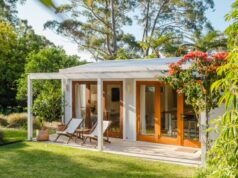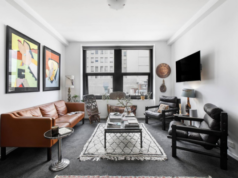
Across Australia, the dream home is getting smaller. Rising construction costs, shrinking land sizes and a growing appetite for sustainable living are changing the way Australians think about space. Out of this shift has come a new design movement focused on compact living. One that celebrates innovation, efficiency and smart design over sheer square metres.
Less space, more purpose
Compact living is not about compromise. It’s about design that works harder and smarter.
“In well-designed small homes, every centimetre has a purpose,” Melbourne architect James Ritchie says, who in compact urban housing.
“You’re not losing anything by going smaller. You’re gaining flexibility, comfort and affordability.”
The trend is visible everywhere, from inner-city infill housing to backyard studios and prefabricated cabins. What once might have been seen as a temporary or fringe solution is now being embraced by young professionals, retirees and families alike.
Part of the appeal is financial. Smaller homes are cheaper to build, heat and cool. But James believes the attraction runs deeper. “People want to live more simply and sustainably,” he says. “They want less maintenance, less clutter and more time for life.”
Designing for function and flow
Good small-space design begins with clear priorities. Open-plan layouts, multi-use zones and seamless indoor-outdoor connections make smaller homes feel larger and more adaptable.
“The first step is to think about how you live,” Brisbane-based Form + Function interior designer Sophie Delaney says. “If you love to cook, invest in a beautiful, efficient kitchen. If you work from home, create a dedicated nook with good light and acoustics. Design for your lifestyle, not someone else’s.”
Storage is also key. Built-in cabinetry, under-stair compartments and concealed joinery help maintain a sense of calm and order. Designers are increasingly turning to flexible furniture such as fold-down desks, modular sofas and extendable tables that shift with daily life.
Natural light plays a crucial role too. Large windows, skylights and glass doors extend sightlines and bring a sense of openness to compact spaces. “You can make a 60-square-metre home feel twice the size through light and clever layout,” Sophie says.
Innovation on the rise
Australia’s appetite for innovation is driving a wave of new small-home solutions. Prefabricated and modular designs are becoming mainstream, offering faster builds with less waste.
“Prefab is no longer a dirty word,” James says. “The technology has evolved. You can have a high-quality, architect-designed home delivered in weeks rather than months.”
Companies across the country are experimenting with adaptable systems that allow home owners to add or reconfigure modules as their needs change. Tiny homes on wheels, granny flats and backyard pods are part of this growing ecosystem, giving people more flexibility in how and where they live.
In regional areas, compact builds are being used for off-grid living, tourism accommodation and farm stays. In cities, they’re offering affordable entry points for first-home buyers and downsizers.
Sustainability and small footprints
The smaller the space, the smaller the footprint. Compact homes are inherently more sustainable, using fewer materials, less energy and less water.
“Designing small is one of the simplest ways to reduce your environmental impact,” Sustainability consultant Anita Kwon says. “It forces you to make intentional choices and focus on quality rather than quantity.”
Many small homes incorporate passive design principles such as natural cross-ventilation, thermal mass and orientation to the sun. Solar panels, rainwater tanks and high-performance insulation further improve efficiency.
Material selection also matters. Lightweight construction, recycled timber and locally sourced products help reduce embodied carbon.
“It’s about designing responsibly, not just beautifully,” Anita says. “A small home can still feel luxurious when it’s thoughtfully built.”
Living well in less space
Beyond the practicalities, compact living is also a cultural shift. It challenges long-held ideas about success and comfort.
“Ten years ago, clients would come in asking how big they could build,” Sophie says. “Now, they ask how clever they can make it.”
Small homes encourage a more mindful way of living. With less room for excess, people are re-evaluating what they truly need. Spaces are becoming more personal, tailored to daily rituals rather than trends.
“There’s a sense of freedom in owning less,” James says. “It’s not about squeezing into a tiny box. It’s about creating a home that fits your life instead of the other way around.”
This mindset has inspired a new aesthetic too. Interiors lean toward calm, natural tones, built-in storage and open shelving that celebrates simplicity. The goal is not minimalism for its own sake, but livability in homes that feel generous, even when they’re small.
Community and connection
Compact living is also influencing how communities are built. Developments featuring small-footprint homes clustered around shared gardens, workspaces or courtyards are gaining traction.
“These designs create community without compromising privacy,” Anita says. “You might have a small home but access to shared amenities that expand your lifestyle like a workshop, rooftop or veggie garden.”
This model aligns with broader social and environmental goals, supporting denser, walkable neighbourhoods that use land and resources more efficiently. For councils grappling with urban sprawl and housing shortages, it’s a promising direction.
A smarter future
As affordability pressures rise, small home innovation is set to play an even greater role in the Australian housing landscape. Builders and designers are rethinking what’s possible within compact footprints, proving that small can indeed be beautiful and functional.
“The challenge used to be convincing people to go smaller,” James says. “Now the question is how to make small living even smarter.”
Whether it’s a modular beach shack, an urban micro apartment or a cleverly renovated terrace, the future of Australian housing is pointing toward flexibility, efficiency and a stronger connection to how we really live.
Compact living is not a passing trend. It’s a reflection of changing values in sustainability, simplicity and design that makes every square meter count.




